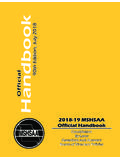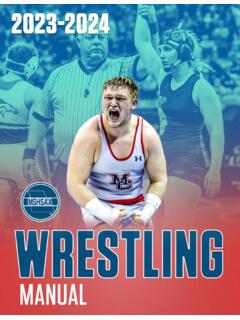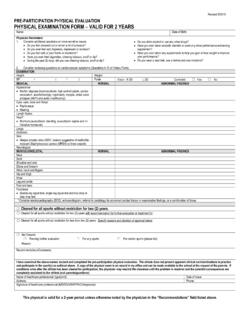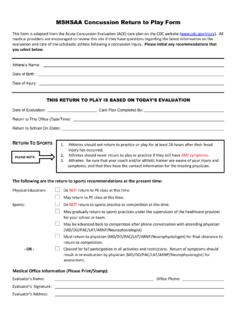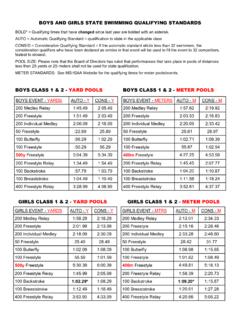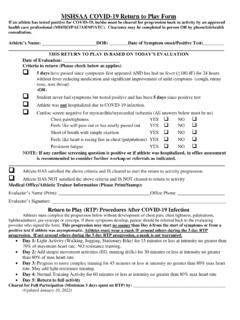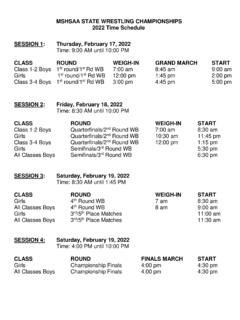Transcription of EMERGENCY ACTION PLANNING - Missouri State High …
1 EMERGENCY ACTION PLANNING . All schools should have a written and rehearsed EMERGENCY ACTION Plan (EAP) for all sponsored activities and venues. School administrators should design a chain of command for medical decision making. A protocol for defining the need for and providing safe transport of an injured athlete must be developed. Significance While interscholastic sports promote health, competition, and teamwork, the risks of catastrophic injury and sudden death exists during both practice and competition. The potential for a medical EMERGENCY is ever present. The purpose of the EMERGENCY ACTION Plan is to facilitate a prompt, efficient, coordinated response in the case of a medical EMERGENCY . PLANNING , preparation, and practice are the keys to achieving success in the case of an actual EMERGENCY . Background All schools and school districts should have an EAP that addresses medical emergencies among athletes, staff, officials, and spectators. The plan should also address severe weather, fire, electrical failure, bomb threat, criminal behavior or other possible emergencies.
2 For purposes of this plan, we will concentrate on the EAP for medical emergencies involving athletes. The prevention and minimization of injury is a year-round, comprehensive effort. Risk of injury is minimized by the pre-participation evaluation of athletes, safety review of venues for practices and contests, proper equipment selection and fit, preseason strength training and conditioning programs, adequate environmental acclimatization, comprehensive rehabilitation following injury, and prudent return-to-activity protocols. The EAP is a blueprint for response to a medical EMERGENCY and activation of the EMERGENCY medical system (EMS). The sports medicine team and administration must be prepared for any EMERGENCY situation. An EAP. should be established for each separate venue and should be in effect at all practices and competitions. A. modified EAP should also be developed for away contests in all sports. A proper plan establishes accountability and should be comprehensive, yet flexible, practical, and easily understood.
3 The written EAP. must be revised, approved, distributed, and rehearsed regularly prior to every athletic season. The athletic department, administration, and sports medicine team share the responsibility to establish, practice, and execute the EAP. COMPONENTS OF THE EAP. 1. Personnel: a. Define the responsibilities of each member of the sports medicine team, coaching staff, and administration. Identify the persons delegated to provide EMERGENCY care. The highest available level of sports medicine expertise should be present at all events, if possible. An athletic trainer or physician should be present for events with a high risk of injury such as football and ice hockey. Given the limited sports medicine staff available to many high schools, coaches and administrators must be expected to be called upon to assist inured athletes. Even if a school employs an athletic trainer, it is not possible for the athletic trainer to attend all practices and contests.
4 It is highly recommended that coaches and administrators be certified in CPR/AED use and First Aid. b. Delegate staff to keep the scene safe, manage spectators, and restrict others from interfering with the sports medicine staff or others providing EMERGENCY care. Officials and coaches should move athletes and family members away from the injured athlete. Players should be educated not to touch, move, pull on, or remove equipment from any injured player. c. Designate a chain of command for medical decision making. The sports medicine team should be empowered with unchallengeable authority in medical decisions for the athlete and in situations where modification of practices or contests due to environmental danger is deemed necessary. 2. Communication: a. Designate telecommunication devices and a list of EMERGENCY phone numbers. Be aware of locations where cell phones may not operate and ensure that hand-held radios and/or landlines are available.
5 B. A written description of the venue and its access points will facilitate a prompt response by EMS. Identify the person charged with contacting EMS in the event of an EMERGENCY . c. Agree to and rehearse hand signals for communication between sports medicine team members on the field and on the sidelines to facilitate rapid activation of EMS. d. Plan for notification of the hospital EMERGENCY department receiving the inured athlete(s). e. Plan for communication with the athlete's family, teammates, and media while honoring the patient confidentially. This is especially important in the event of a catastrophic injury. 3. Equipment: a. Mandatory EMERGENCY equipment includes tools for facemask removal, spine and extremity immobilization, airway management, and AED. b. All equipment must be regularly checked and well maintained. AED's should be maintained as per their manufacturer instructions with regular changes of batteries and pads. c. Each member of the sports medicine team, as well as coaches and administrators, should be knowledgeable and cross trained in all of the techniques and equipment to be used in an EMERGENCY .
6 4. EMERGENCY Medical Care: a. Follow basic first aid and/or CPR/AED protocols. b. Observation of the mechanism of injury allows rapid anticipation of the resulting injury and its severity. c. Everyone assisting with the care of an injured athlete must work as a team. No single healthcare discipline should have entitlement to the supervision or performance of any particular aspect of the rescue. The individual at the athlete's head is in charge until that responsibility is transferred to and accepted by another member of the team. d. If a neck injury is suspected, stabilize the head and neck until cervical spine injury is ruled out. If the athlete is unconscious, always assume that there is a spine injury. e. Decisions of how and when to transport an injured athlete from the field should follow a set protocol. If no parent or guardian is available, there must be a protocol for contacting them and at least one adult should accompany the injured athlete to the hospital.
7 5. Information: a. Plan to keep a small file (paper or electronic) with each athlete's medical information and parental consent form. This file must be available at all practices and contests (home and away). b. Important data to have on file includes: past medical history, present medications; allergies; tetanus vaccination status; EMERGENCY contact information; primary care provider information; signed consent for examination, treatment, transport, and sharing of medical and insurance information. 6. Gameday: a. Review of the EAP by the leadership of the home and away teams and officials prior to the start of play. b. Identify those athletes who may be at special risk given past medical history or recent illness or injury. c. Ensure equipment and telecommunication devices are present and functioning. Ensure that the venue is accessible by EMS personnel and vehicles. d. Survey the environmental conditions and the playing field for potential dangers.
8 An inclement weather plan should delegate responsibility and protocol for decision-making in case of heat, cold, rain, or lightning. Provide an evacuation plan for each team, officials, and spectators in case of environmental or other universal danger. 7. Catastrophic Incident Plan: a. Injuries resulting in death or permanent disability are uncommon. The aftermath of such tragedies is a time of sadness and confusion for everyone involved. School administrators are well-served at such times by a separate Catastrophic Incident Plan. b. The plan should delegate a management team that collects accurate information; provides official communication; provides institutional risk management; follows a flow chart of communication/notification; coordinates legal, medical, police, and media interaction; and keeps a chronological record of the events leading to and following the incident. Sideline Preparedness Items The NFHS SMAC suggests the following items be available on the sidelines for all practices and competitors to facilitate appropriate care for a sick or injured athlete when an athletic trainer is not present.
9 Actual items for each venue should be determined in consultation with the athletic trainer or team physician. First Aid Kit: Athletic Tape Pre-Wrap Band-Aids of various shapes and sizes Sterile Gauze Iodine, Hydrogen Peroxide or other antiseptic Triple Antibiotic Ointment Disposable Latex Gloves Scissors Eye Wash with Cup (to rinse foreign bodies). Dental Kit in case of tooth loss Saline Solution (for athletes with contact lenses). Petroleum Jelly (to stop chafing skin). Ice Bags CPR Mask Face-mask removal tool such as a screwdriver, Trainers Angel, FM Extractor, or a modified anvil pruner. A backup removal tool should also be on hand if a screwdriver is the first tool of choice. Medical Resource Binder or readily available electronic access to: Athlete EMERGENCY medical cards and authorizations Injury report forms List of phone numbers and addresses of all local hospitals in each town or county to which the team travels Authorized Items for Individual Athletes: These items are for use by the individual athlete who has been prescribed to use them by his/her primary care provider, as indicated on the EMERGENCY card or other medical documentation; these items are not to be shared with other athletes).
10 Before carrying these items, institutions should check with individual State laws and school policies concerning the carrying and dispensing of medications to minors. Asthma inhalers Bee-sting kits ( , Epi-pen). Diabetic kits Other prescription medications THE COACH'S ROLE IN THE EAP. Many high schools do not have the services of an athletic trainer. During practice or competition, athletes are often in need of first aid or other care when an athletic trainer or other healthcare professional is not physically present. In these situations, the head coach and other members of the coaching staff must have the basic knowledge and supplies on the sidelines to facilitate appropriate care for the athletes, commensurate with the coaches training ( , CPR/AED and first aid). While not all injuries are preventable, a properly trained coach may effectively control or lessen the incidence or consequence of an injury through appropriate initial first aid and EMERGENCY care.
